FORD CONTOUR 1999 2.G Manual Online
Manufacturer: FORD, Model Year: 1999, Model line: CONTOUR, Model: FORD CONTOUR 1999 2.GPages: 244, PDF Size: 2.26 MB
Page 81 of 244
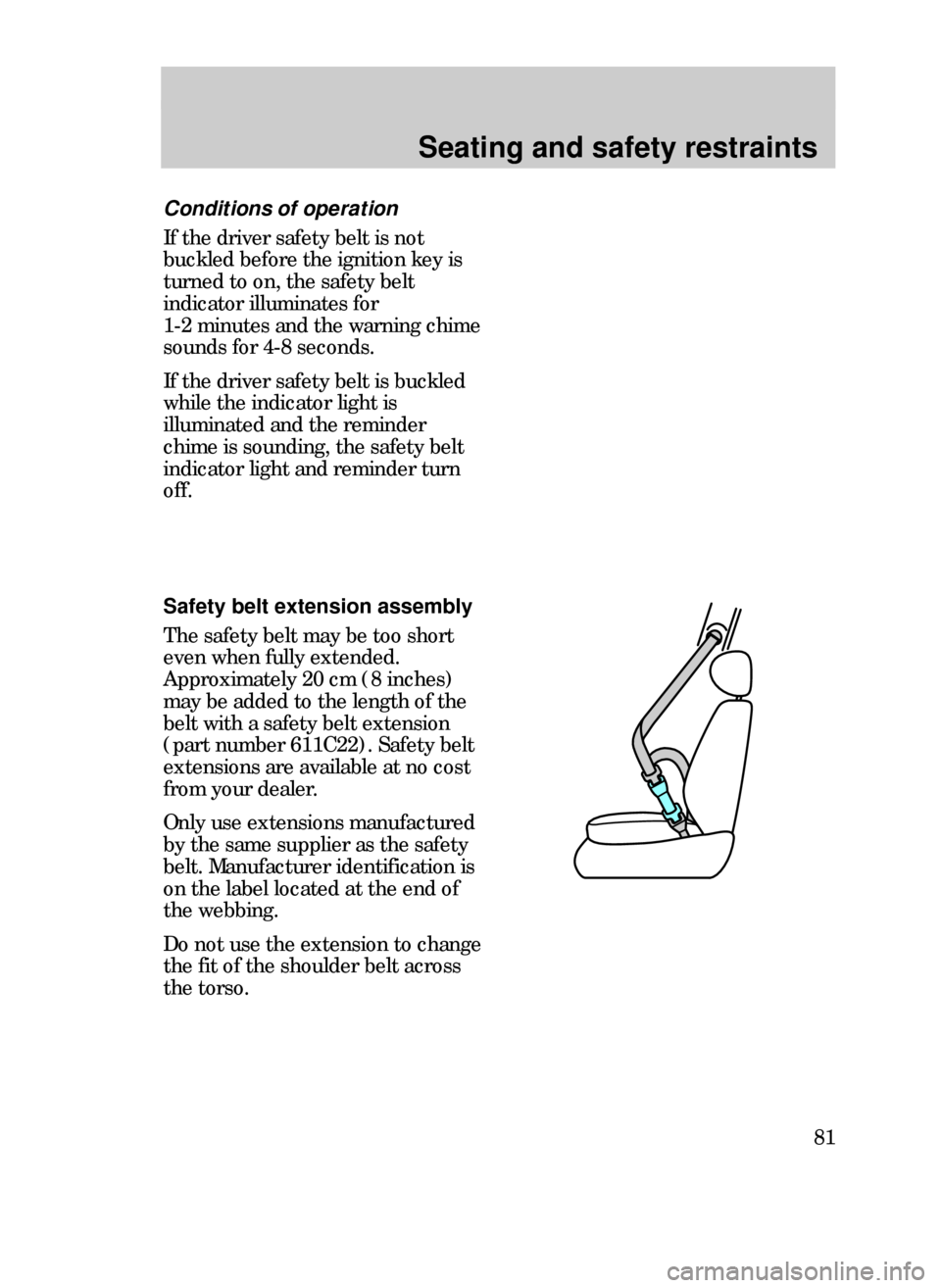
Seating and safety restraints
81
Conditions of operation
If the driver safety belt is not
buckled before the ignition key is
turned to on, the safety belt
indicator illuminates for
1-2 minutes and the warning chime
sounds for 4-8 seconds.
If the driver safety belt is buckled
while the indicator light is
illuminated and the reminder
chime is sounding, the safety belt
indicator light and reminder turn
off.
Safety belt extension assembly
The safety belt may be too short
even when fully extended.
Approximately 20 cm (8 inches)
may be added to the length of the
belt with a safety belt extension
(part number 611C22). Safety belt
extensions are available at no cost
from your dealer.
Only use extensions manufactured
by the same supplier as the safety
belt. Manufacturer identification is
on the label located at the end of
the webbing.
Do not use the extension to change
the fit of the shoulder belt across
the torso.
14CSSen 3/25/99 1:59 PM Page 81
Page 82 of 244
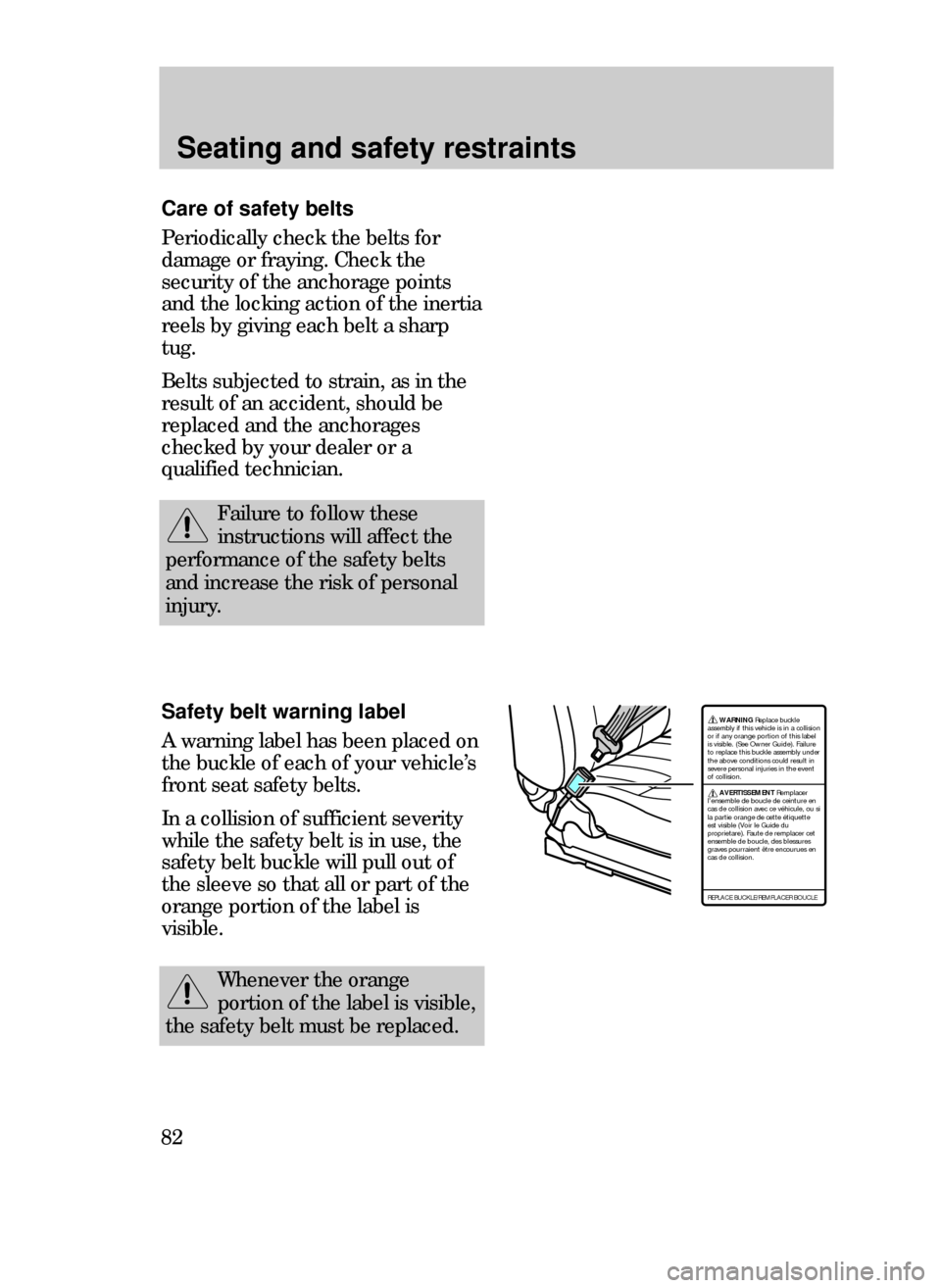
Seating and safety restraints
82
Care of safety belts
Periodically check the belts for
damage or fraying. Check the
security of the anchorage points
and the locking action of the inertia
reels by giving each belt a sharp
tug.
Belts subjected to strain, as in the
result of an accident, should be
replaced and the anchorages
checked by your dealer or a
qualified technician.
Failure to follow these
instructions will affect the
performance of the safety belts
and increase the risk of personal
injury.
Safety belt warning label
A warning label has been placed on
the buckle of each of your vehicleÕs
front seat safety belts.
In a collision of sufficient severity
while the safety belt is in use, the
safety belt buckle will pull out of
the sleeve so that all or part of the
orange portion of the label is
visible.
Whenever the orange
portion of the label is visible,
the safety belt must be replaced.
WARNING Replace buckle
assembly if this vehicle is in a collision
or if any orange portion of this label
is visible. (See Owner Guide). Failure
to replace this buckle assembly under
the above conditions could result in
severe personal injuries in the event
of collision.
AVERTISSEMENT Remplacer
l'ensemble de boucle de ceinture en
cas de collision avec ce véhicule, ou si
la partie orange de cette étiquette
est visible (Voir le Guide du
proprietare). Faute de remplacer cet
ensemble de boucle, des blessures
graves pourraient être encourues en
cas de collision.
REPLACE BUCKLE/REMPLACER BOUCLE
14CSSen 3/25/99 1:59 PM Page 82
Page 83 of 244
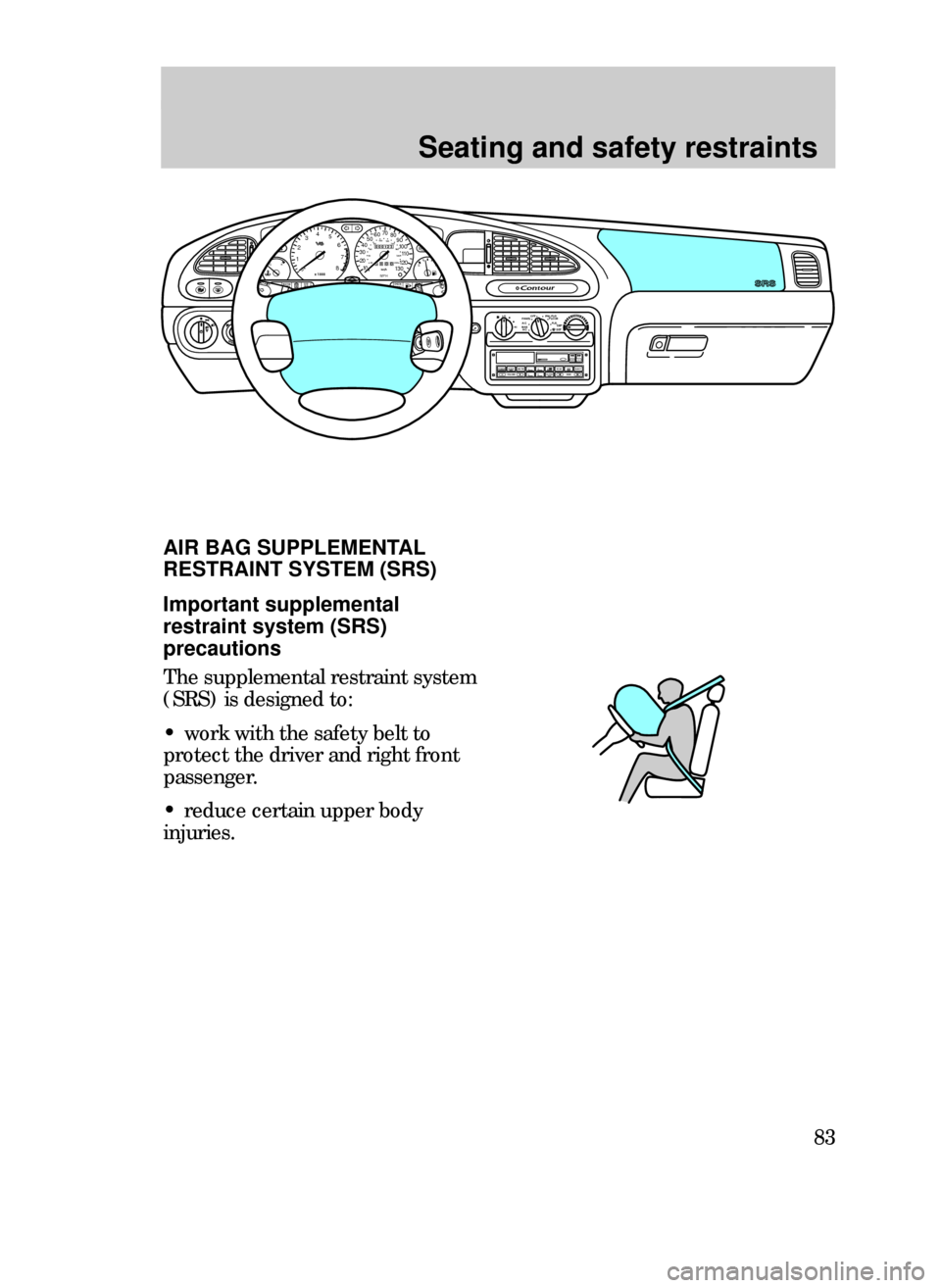
Seating and safety restraints
83
Important supplemental
restraint system (SRS)
precautions
The supplemental restraint system
(SRS) is designed to:
¥ work with the safety belt to
protect the driver and right front
passenger.
¥ reduce certain upper body
injuries.
AIR BAG SUPPLEMENTAL
RESTRAINT SYSTEM (SRS)
MIRRORS
OFF LO PNL/FLR
PANEL
A/CFLOOR
DEF FLR
DEF
MAX
A/C HI/
POWER AUDIO AM/FM
SCAN
SEEK 31245ANSSIDE 1-2EJECTVOLUME
000123000010 20 3040506070
80
90
10 0
110
120
13 0MPH20 406055
80120 10 0
14 0
160
18 0
200EF12
03x 1000
4
5
6
7
8BRAKE
CHECK
ENGINEO/D
OFF
CLOCK
TRACTION
TROLCH
14CSSen 3/25/99 1:59 PM Page 83
Page 84 of 244
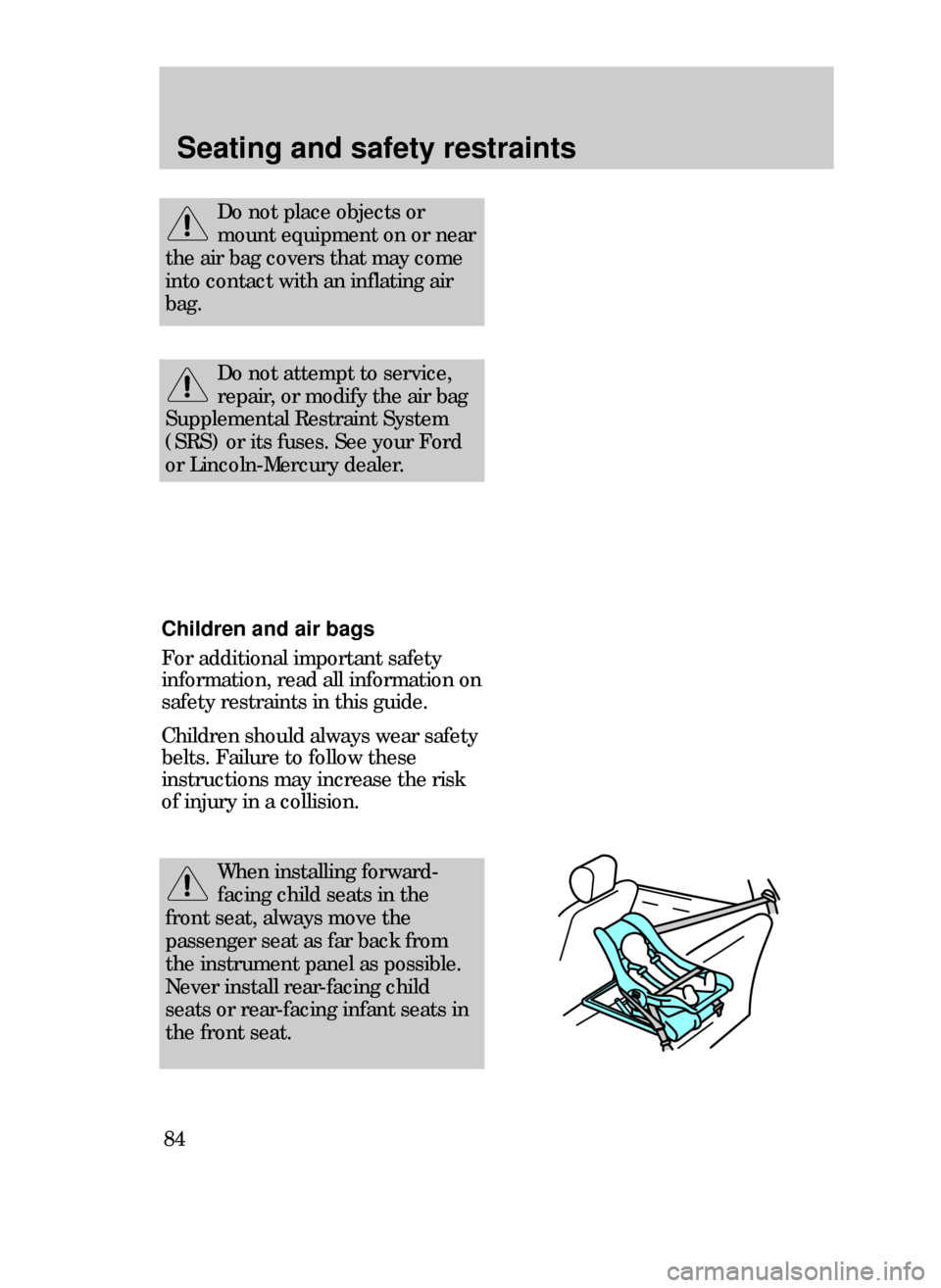
Seating and safety restraints
84
Do not attempt to service,
repair, or modify the air bag
Supplemental Restraint System
(SRS) or its fuses. See your Ford
or Lincoln-Mercury dealer.
When installing forward-
facing child seats in the
front seat, always move the
passenger seat as far back from
the instrument panel as possible.
Never install rear-facing child
seats or rear-facing infant seats in
the front seat.
Children and air bags
For additional important safety
information, read all information on
safety restraints in this guide.
Children should always wear safety
belts. Failure to follow these
instructions may increase the risk
of injury in a collision.
Do not place objects or
mount equipment on or near
the air bag covers that may come
into contact with an inflating air
bag.
14CSSen 3/25/99 1:59 PM Page 84
Page 85 of 244
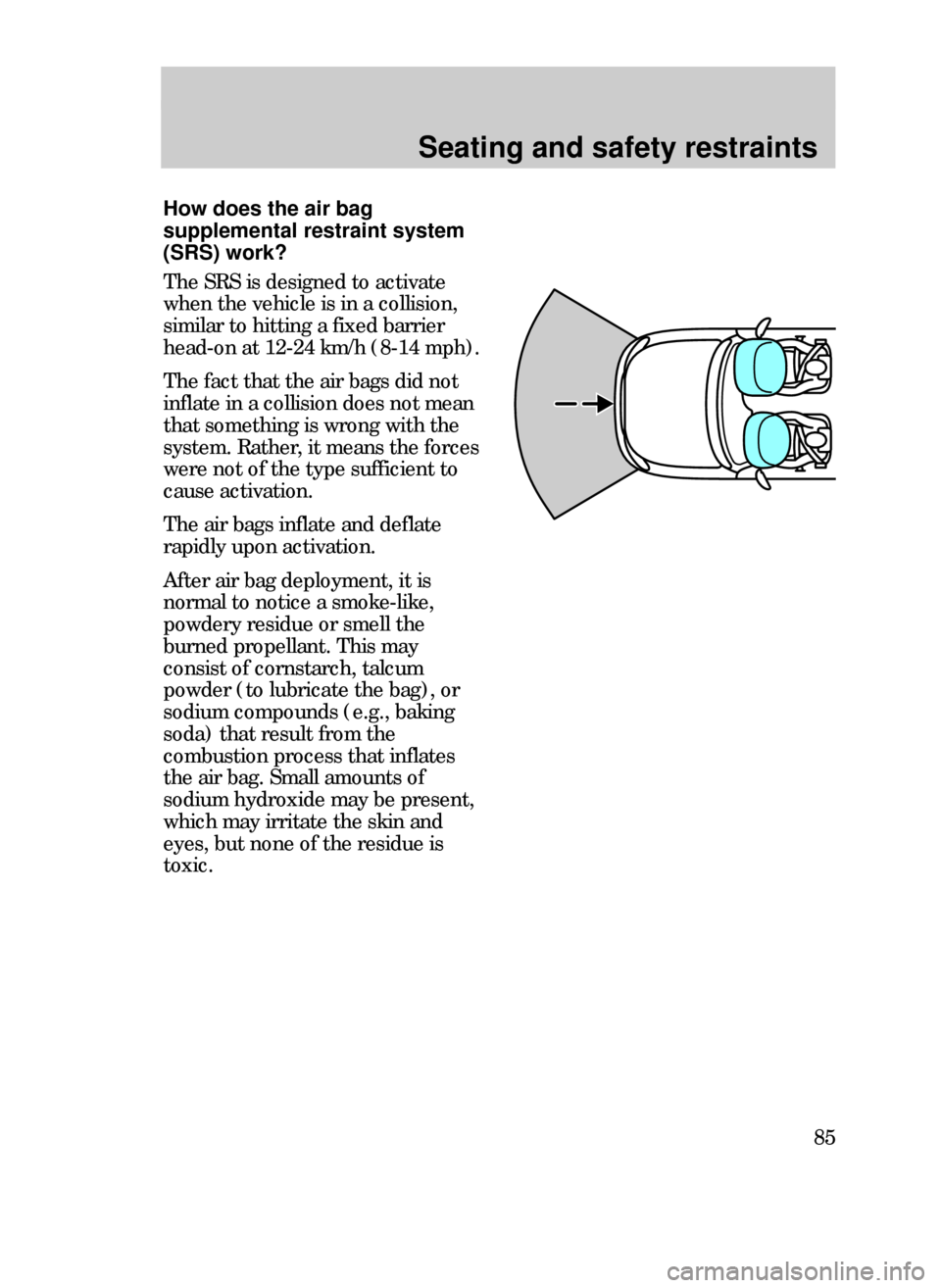
Seating and safety restraints
85
How does the air bag
supplemental restraint system
(SRS) work?
The SRS is designed to activate
when the vehicle is in a collision,
similar to hitting a fixed barrier
head-on at 12-24 km/h (8-14 mph).
The fact that the air bags did not
inflate in a collision does not mean
that something is wrong with the
system. Rather, it means the forces
were not of the type sufficient to
cause activation.
The air bags inflate and deflate
rapidly upon activation.
After air bag deployment, it is
normal to notice a smoke-like,
powdery residue or smell the
burned propellant. This may
consist of cornstarch, talcum
powder (to lubricate the bag), or
sodium compounds (e.g., baking
soda) that result from the
combustion process that inflates
the air bag. Small amounts of
sodium hydroxide may be present,
which may irritate the skin and
eyes, but none of the residue is
toxic.
14CSSen 3/25/99 1:59 PM Page 85
Page 86 of 244

Seating and safety restraints
86
If the air bag is inflated, the
air bag will not function
again and must be replaced
immediately.If the air bag is not
replaced, the unrepaired area will
increase the risk of injury in a
collision.
The SRS consists of the following:
¥ driver and passenger air bag
modules (which include the
inflators and air bags),
¥ one impact and one safing sensor,
¥ a readiness light and a secondary
warning light, and
¥ the electrical wiring and
components.
The diagnostic module monitors its
own internal circuits and the
supplemental air bag electrical
system readiness (including the
impact sensors), the system wiring,
the air bag system readiness light,
the air bag backup power, and the
air bag ignitors.
Several air bag system
components get hot after
inflation. Do not touch them after
inflation.
14CSSen 3/25/99 1:59 PM Page 86
Page 87 of 244
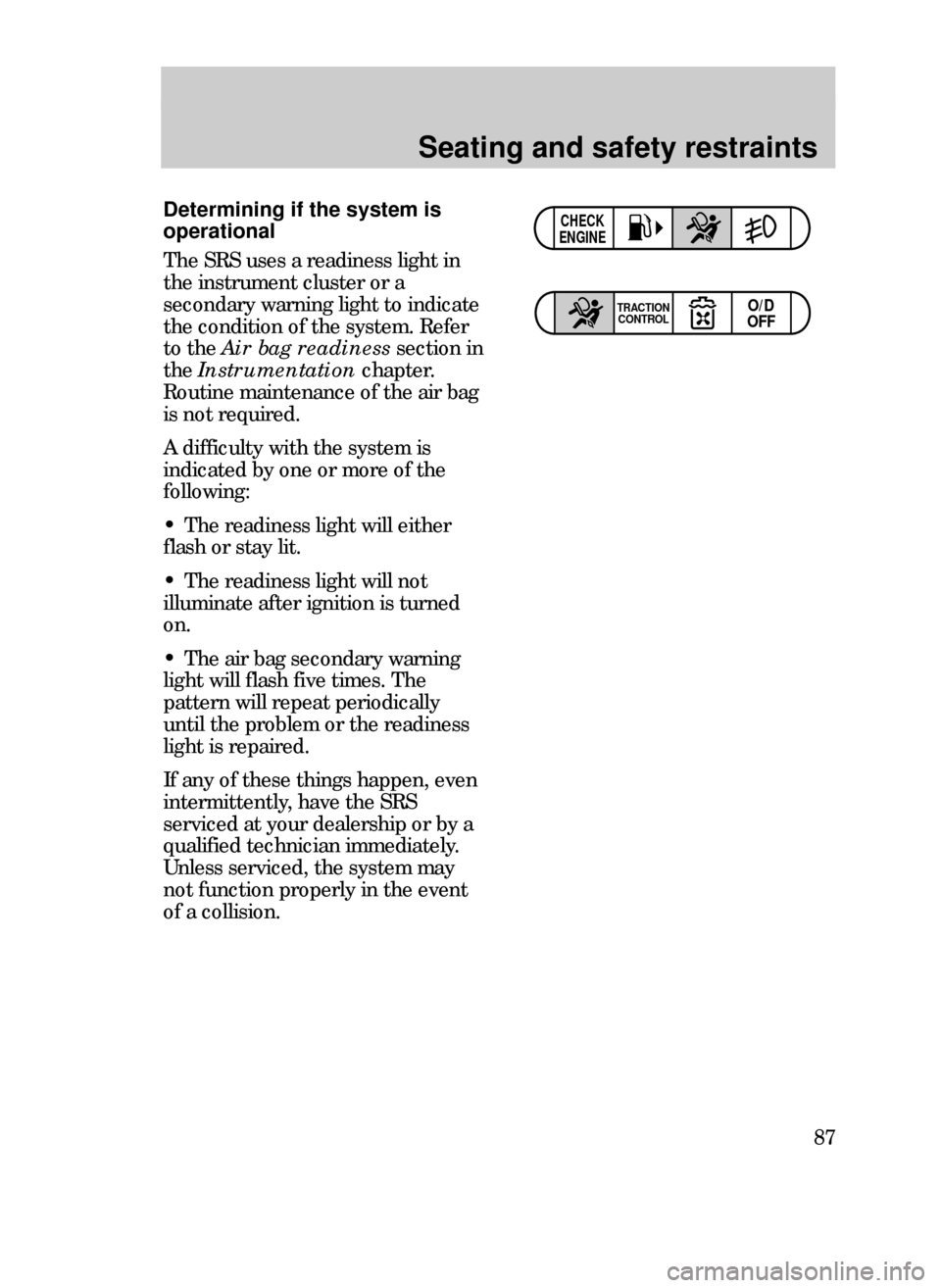
Seating and safety restraints
87
Determining if the system is
operational
The SRS uses a readiness light in
the instrument cluster or a
secondary warning light to indicate
the condition of the system. Refer
to the Air bag readinesssection in
the Instrumentationchapter.
Routine maintenance of the air bag
is not required.
A difficulty with the system is
indicated by one or more of the
following:
¥ The readiness light will either
flash or stay lit.
¥ The readiness light will not
illuminate after ignition is turned
on.
¥ The air bag secondary warning
light will flash five times. The
pattern will repeat periodically
until the problem or the readiness
light is repaired.
If any of these things happen, even
intermittently, have the SRS
serviced at your dealership or by a
qualified technician immediately.
Unless serviced, the system may
not function properly in the event
of a collision.CHECK
ENGINE
O/D
OFFTRACTION
CONTROL
14CSSen 3/25/99 1:59 PM Page 87
Page 88 of 244

Seating and safety restraints
88
Disposal of air bags and air bag
equipped vehicles
For disposal of air bags or air bag
equipped vehicles, see your local
dealership or a qualified technician.
Air bags MUST BE disposed of by
qualified personnel.
14CSSen 3/25/99 1:59 PM Page 88
Page 89 of 244
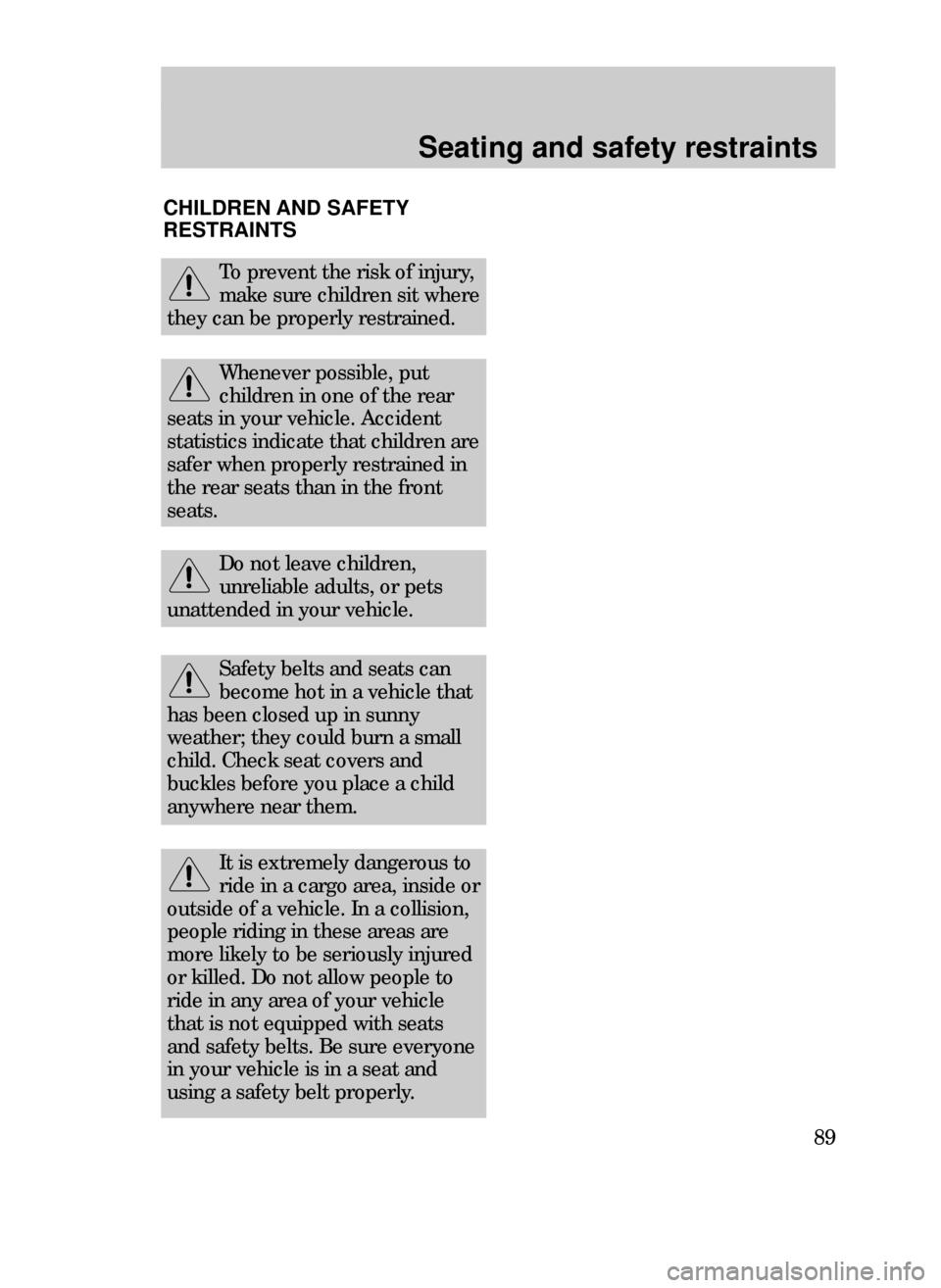
Seating and safety restraints
89
Safety belts and seats can
become hot in a vehicle that
has been closed up in sunny
weather; they could burn a small
child. Check seat covers and
buckles before you place a child
anywhere near them.
Do not leave children,
unreliable adults, or pets
unattended in your vehicle.
To prevent the risk of injury,
make sure children sit where
they can be properly restrained.
CHILDREN AND SAFETY
RESTRAINTS
It is extremely dangerous to
ride in a cargo area, inside or
outside of a vehicle. In a collision,
people riding in these areas are
more likely to be seriously injured
or killed. Do not allow people to
ride in any area of your vehicle
that is not equipped with seats
and safety belts. Be sure everyone
in your vehicle is in a seat and
using a safety belt properly.
Whenever possible, put
children in one of the rear
seats in your vehicle. Accident
statistics indicate that children are
safer when properly restrained in
the rear seats than in the front
seats.
14CSSen 3/25/99 1:59 PM Page 89
Page 90 of 244
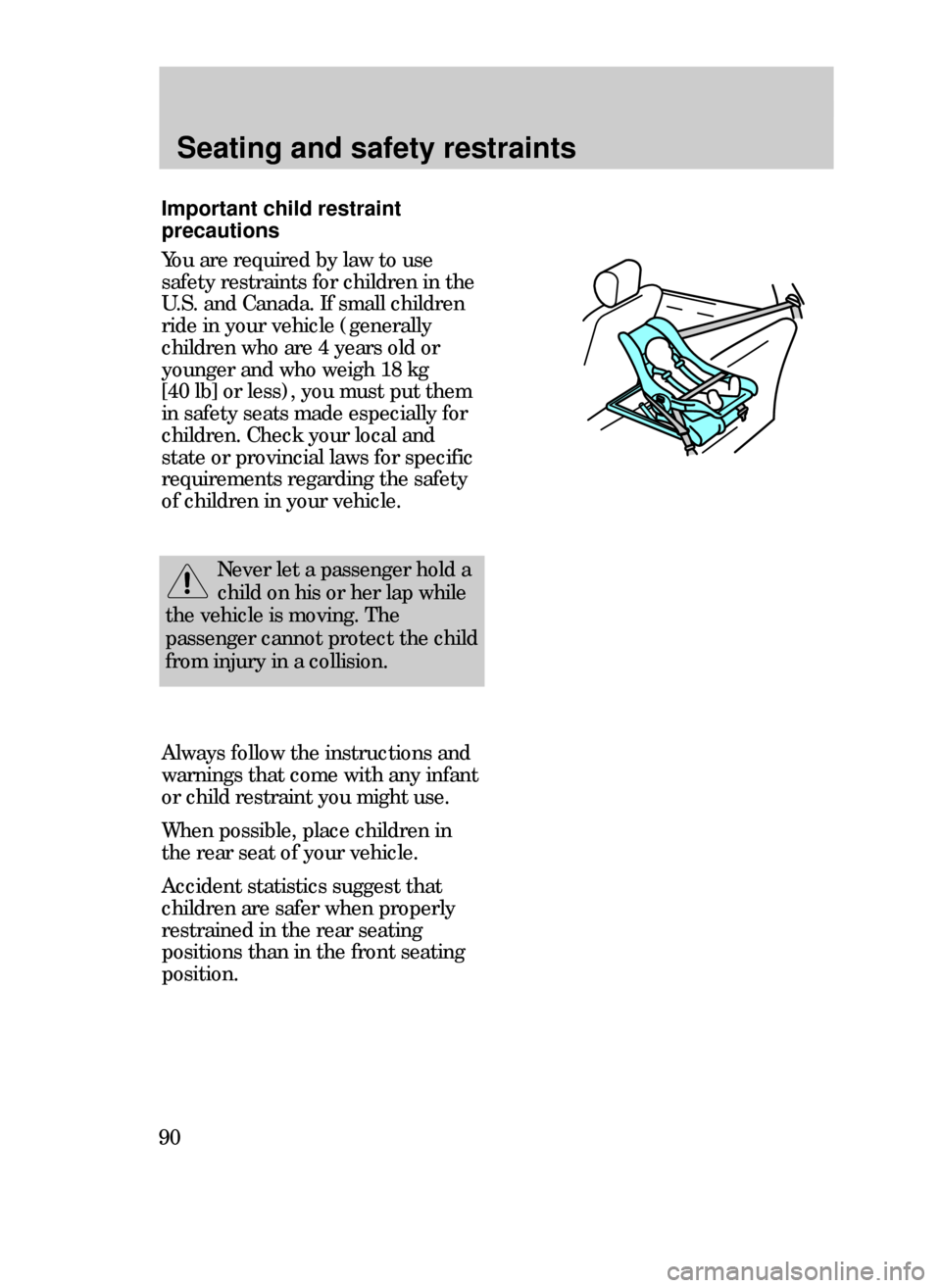
Seating and safety restraints
90
Important child restraint
precautions
You are required by law to use
safety restraints for children in the
U.S. and Canada. If small children
ride in your vehicle (generally
children who are 4 years old or
younger and who weigh 18 kg
[40 lb] or less), you must put them
in safety seats made especially for
children. Check your local and
state or provincial laws for specific
requirements regarding the safety
of children in your vehicle.
Never let a passenger hold a
child on his or her lap while
the vehicle is moving. The
passenger cannot protect the child
from injury in a collision.
Always follow the instructions and
warnings that come with any infant
or child restraint you might use.
When possible, place children in
the rear seat of your vehicle.
Accident statistics suggest that
children are safer when properly
restrained in the rear seating
positions than in the front seating
position.
14CSSen 3/25/99 1:59 PM Page 90